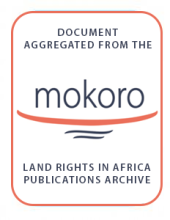/ library resources
Showing items 1 through 9 of 15.Climate change impacts livelihoods adversely in dry-lands of Northern Kenya in terms of longer and harsher droughts, shorter and intense precipitation and floods. Climate change interlocks with peoples life-worlds differently for different reasons.
Land Use and Land Cover Change (LULCC) is the most prominent cause of Soil Organic Carbon (SOC) variability in any landscape.
The objective of the study was to detect and identify land cover changes in Laikipia County of Kenya that have occurred during the last three decades. The land use types of study area are six, of which three are the main and the other three are the minor.
Covers the rush to acquire land in Africa by foreign governments and private investors, fuelled by fears for global food security in the face of climate change and volatile food prices on the international market.
The rising conflicts between farmers and pastoralists threaten Nigeria’s food security, economic stability and ecological balance.
Covers land law reform; the role of the full ‘bundle of land rights’, which extends well beyond ownership rights; how Rwanda’s Regional Crop Specialization Policy and Crop Intensification Programme work; the impact of land use consolidation, including on farmers’ resilience to climate change; and
Report brings together the multiple legal strands that weave together and form the context of farmland investments and water rights.
A brief on the need to secure land rights for the world’s pastoralists, who manage rangelands that cover a quarter of the world’s land surface but have few advocates.
Over the last two decades, 200 million people across the world have been lifted out of hunger.
Pagination
Land Library Search
Through our robust search engine, you can search for any item of the over 73,000 highly curated resources in the Land Library.
If you would like to find an overview of what is possible, feel free to peruse the Search Guide.


